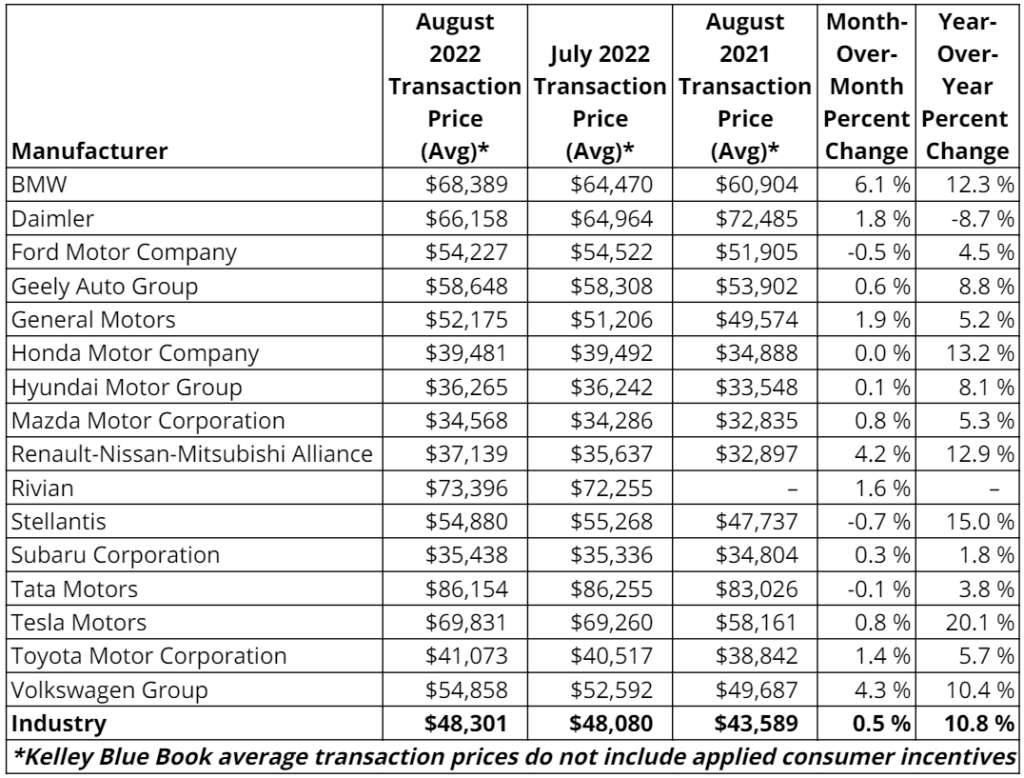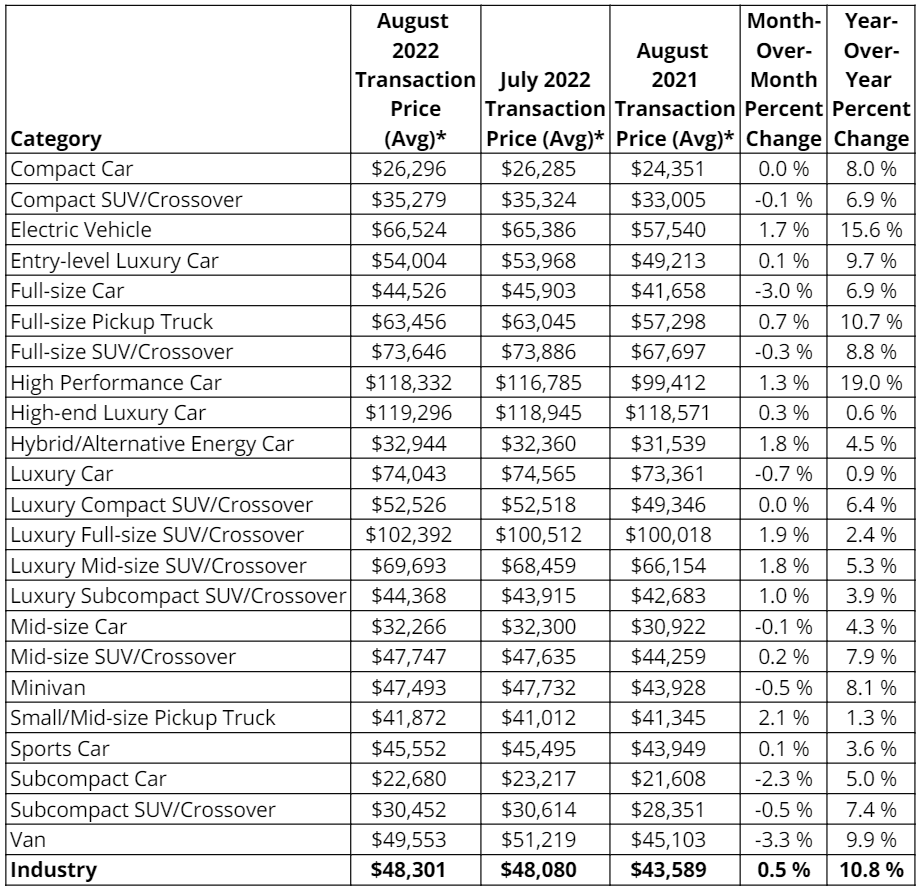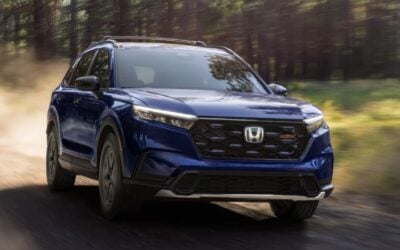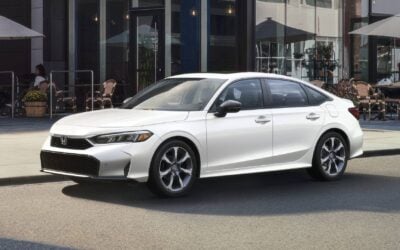For the fifth-month in a row, new car prices climbed to a new record in August. Car buyers continue to pay more, even as signs point towards the bubble bursting. The latest industry insights from Kelly Blue Book and TrueCar make it clear that new car prices have yet to peak.
New Car Prices Rise: The Average Transaction Price Climbs to $48,301 in August
According to new data released this week by Kelley Blue Book, the new vehicle average transaction price (ATP) increased to $48,301 in August 2022, climbing 0.5% since July. August’s new car prices were 10.8% higher ($4,712) year-over-year from August of 2021. Luxury sales remain very strong, now making up 17.5% of overall market share.

There were 1.2 million units in inventory in August. At 43 days’ supply, that’s an improvement year-over-year. Still, new car inventory remains well below historical norms. See the latest new car inventory for each manufacturer here.
Ram, Volvo, Lincoln, Buick, Alfa Romeo and Fiat have the most competitive prices right now, selling 1% or more below MSRP in August. Hyundai, Land Rover, Honda and Kia continue transacted between 5-and-9% over sticker last month. Non-luxury vehicle buyers paid on average $1,102 above sticker price, an increase from July.
The average price paid for a new non-luxury vehicle last month was $44,559. Luxury buyers paid $65,935 on average, but KBB points out that luxury prices are averaging closer to MSRP than they had in months past. Non-luxury buyers paid $1,102 over MSRP in August, an increase since July.
Electric Vehicle Prices Climb in 2022

What price parity? It might be time to give up on that dream, at least for the short-term. The average price paid for a new electric vehicle rose by 1.7% in August. EV prices are now 15.6% higher than they were one year ago. The average price for a new electric vehicle is now $66,524, according to Kelley Blue Book.
Here’s how each market segment fared in August:

Throwback: Remember Manufacturer Incentives?
Manufacturer incentives slowed to a trickle in the second half of 2021, and they’ve yet to return in any meaningful way. KBB found that incentives decreased slightly in August, averaging only 2.3% of the average transaction price. Incentive spending remains at 20-year lows.
Some OEMs are more generous than others right now. Data from TrueCar shows that Stellantis (Jeep, Dodge, Ram, Chrysler) incentives are highest right now, but only at 4.6% of ATP on average. Volkswagen, Nissan and General Motors were all between 3.3% and 3.6% of ATP in August. For perspective, most automakers were offering incentives totaling between 6% and 8% of transaction prices one year ago.
Automakers Intend to Keep Inventory Low, and New Car Prices High
August’s average ATP of $48,301 is more than 80% of the median household income in 15 states. How much worse can it get before new car prices come back to reality? Sadly, even automaker executives note that they’re still selling every car they can manage to make right now. Demand remains strong, so there’s no incentive to lower prices right now.
In fact, automakers are being forthright about their realization that keeping dealer lot inventory slim is best for them and the dealers. This summer, Nissan executive Ashwani Gupta shared the brand’s intention to keep inventory low, and his acknowledgement of who this strategy benefits.
“We have learned that this is more efficient,” Gupta said. “And this is good for dealers. The dealer is ordering a car that is already requested by a customer.”
Today’s car buyers have more leverage than at any time in the past year, if only they would negotiate a deal on a used car insteadWe’ve heard it all before, but what makes August’s data significant is the contrast with now 12 weeks in a row of major weekly price declines at wholesale auctions.
Car Buyers Partly to Blame As the Used Car Bubble Bursts in Slow Motion
As the average price of a new car continues to inch towards $50,000, we must take a step back to understand how we got here, and where we’re headed. On the new vehicle front, the new record was driven by the continued popularity of luxury models, tight but improving inventory, and historically low manufacturer incentives.
Kelley Blue Book notes that luxury share remains near an all-time high at 17.5% of auto sales. This inevitably pushes market averages higher, but it points to a larger underlying problem – new cars are becoming a luxury item out of reach for many. Automakers continue to announce cancellations of their more affordable offerings. The Chevy Sonic, Hyundai Veloster, Mazda CX-3 and Volkswagen Passat to name a few. It’s clear that they’re laser-focused on higher-margin models, no matter how much it further damages vehicle affordability.
Things Are Quite Different in the Used Car Market
We’ve pointed out for weeks that your best shot at a deal is in the used car market right now. You don’t have to spend over $50,000 on a new car with a $1,000/month payment. The used car market is certainly softening at wholesale auctions. Wholesale prices are down roughly 7.5% in three months, with luxury segments seeing sharper declines.
Think Twice About Buying New; Negotiate 10% Off Used Car Prices Today
Dealers are becoming anxious about the real possibility of losing money on used inventory they paid too much for just weeks ago. It costs them money to hold inventory, and they’re eager to sell right now. Everyone should be able to negotiate 5% to 10% off of the sticker price right when shopping used vehicles right now. Not sure how to go about doing that? Our very own auto experts are ready to empower you with the skills at the CarEdge Community.













0 Comments